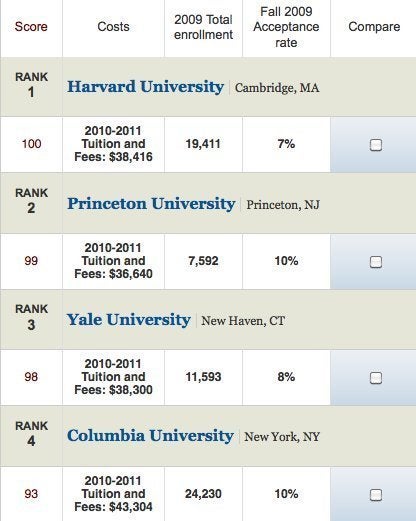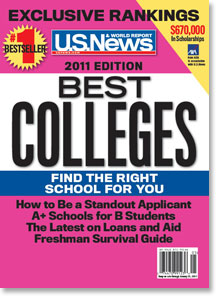
If April showers bring May flowers, what does July heat bring?
Not August meat.
August is instead open season on college rankings -- which are, of course, mostly fluff. The idea that the overall quality of U.S. colleges and universities can be reduced to a single number, which allows institutions to be rank-ordered first to last, is hugely problematic.
But it's also hugely popular.
 America has a love affair with Top 10 lists, and not just of the David Letterman variety. We love rankings - largely because they provide an easily digestible way in our busy and complex world to know, or think we know, which things are better than other, similar things. U.S. News & World Report has been a leader in the field of rankings, putting out lists since time immemorial not just on the top U.S. colleges and universities, but also on everything from the country's best hospitals, health plans and nursing homes to the best cars, trucks and hybrids.
America has a love affair with Top 10 lists, and not just of the David Letterman variety. We love rankings - largely because they provide an easily digestible way in our busy and complex world to know, or think we know, which things are better than other, similar things. U.S. News & World Report has been a leader in the field of rankings, putting out lists since time immemorial not just on the top U.S. colleges and universities, but also on everything from the country's best hospitals, health plans and nursing homes to the best cars, trucks and hybrids.
What are the best mutual funds? U.S. News will tell you. The best places to retire? The magazine's got that covered, too.
On August 17th, U.S. News & World Report released its "Best Colleges 2011" rankings, and the usual suspects again topped the lists: Harvard, Princeton and Yale in the "national universities" category, and Williams, Amherst and Swarthmore in the "national liberal arts" category.
Elsewhere, these schools didn't fare too well. The "What Will They Learn?" rankings, a project of the American Council of Trustees and Alumni (ACTA), gives Yale, Williams, Amherst and Swarthmore each an F for requiring students to take one or zero courses in its favored subject-areas (composition, literature, foreign language, U.S. government or history, economics, mathematics, and natural or physical science). Princeton escaped with a C for requiring three courses in these seven areas, while Harvard squeaked by with a D (requiring two of the seven).
Forbes, meanwhile, entered into the rankings fray in 2008. Interestingly, its rankings take into account the average amount of debt that students graduate with, as well as the rate at which students in a given institution default on their loans. Student debt-load and loan-defaults are on everyone's mind right now because of the tough economy, but also because of recent inquiries into the for-profit college industry initiated by Sen. Tom Harkin (D-IA).
Last Friday at 5:15 pm, when most of the country had checked out for the weekend, the U.S. Department of Education quietly published four-year loan-repayment rates and average debt-load for students at over 8,400 institutions of higher education. The for-profit industry went into a tailspin for the second time in as many weeks because the repayment rates and debt-loads of students at for-profit colleges were bleaker than many had hoped or expected. (For-profits were also shaken on August 2nd when a report by the Government Accountability Office found deceptive recruiting practices at all 15 institutions it had secretly investigated.)
According to an August 14th article in The New York Times, "outside advocacy groups that analyzed the data found that in 2009, [loan-] repayment rates were 54 percent at public colleges and universities, 56 percent at private nonprofit institutions, and 36 percent at for-profit colleges."
Repayment rates and average student debt-loads for all 8,400 institutions can be found here. A few institutions did manage to have 100 percent repayment rates - the 4-States Okmulgee Academy of Cosmetology and Aladdin Beauty College #1 were among them -- but more often than not these schools had to count on only one graduate to repay his or her loans. Large institutions tended to have a less impressive showing. The University of Phoenix had almost 350,000 students enter repayment in 2009, with nearly $5 billion in outstanding loans. Its estimated repayment rate? Forty-four percent.
For those who work their way beyond its list of America's top 50 colleges and universities, U.S. News & World Report also provides interesting data on the debt-load of students in the Class of 2009. The distinction of being the institution whose students graduated deepest in debt last year belongs to La Roche College in Pennsylvania, where 78 percent of students graduated with debt -- to the tune of $69,494 on average. No other college comes close to La Roche in graduating students with such significant debt.
In second place is Oral Roberts University in Oklahoma, whose graduates left school with an average debt of $49,007, though 55 percent of its students managed to graduate with no debt at all. Elsewhere, 99 percent of Livingstone College students and 98 percent of Bennett College students graduated with debt. The debt-load of graduates from these two institutions, both in North Carolina, averaged about $35,000.
Predictably, few public institutions populate the list of schools that graduate students knee-deep in debt. (Exceptions include the University of North Dakota, Kentucky State University and the Maine Maritime Academy, where more than two-thirds of graduates left school with an average of about $35,000 in debt.) Private, nonprofit schools as well as for-profit schools dominate the list of students graduating with crushing debt.
But there is some good news, too. A handful of institutions do an enviable job of getting their graduates out the door with little or no debt, and it turns out there's a fairly strong correlation between highly ranked schools and schools whose graduates owe almost nothing. But a confounding factor, of course, is that more affluent students tend to attend these institutions in the first place, so it's little wonder they can graduate almost debt-free.
Take Princeton University, for example: only 22 percent of students graduate in debt, and the average amount owed is a meager $5,667. This is partly a function of the fact that Princeton provides its students with very generous financial aid packages -- made up entirely of grants rather than loans since 2001 -- but it's also a result of the fact that Princeton students are, on average, very affluent. Two out of five Princeton students in the Class of 2013 could afford to pay the full cost of attendance -- $52,180 in 2010-11 -- without any financial aid. But, to Princeton's credit, it has become more socioeconomically diverse in the last decade. Back in 2001, three out of five Princeton students were affluent enough not to qualify for any financial aid.
Other schools that do a good job of graduating their students with minimal debt include the University of New Orleans, the University of North Carolina-Chapel Hill, Towson University (in Maryland), the U.S. Merchant Marine Academy (in New York) and Claremont McKenna College (in California). All of these but Claremont McKenna are public institutions, and all graduate more than two-thirds of their students debt-free. Of the 29 percent who owe money upon graduation from the U.S. Merchant Marine Academy, the average debt is only $6,416.
The higher education landscape in the U.S. is tremendously vast and varied. Students and parents alike would be well-advised to look not just as the flashy top 50 lists of best colleges and universities, but also to scrutinize the less sexy but equally or more important list of average student debt-load.
